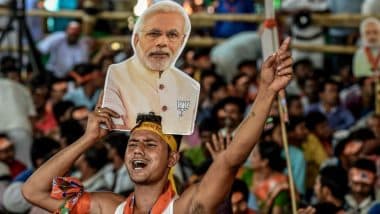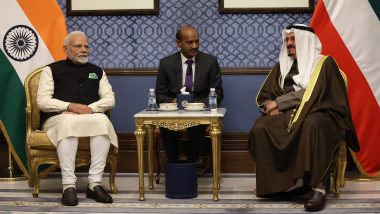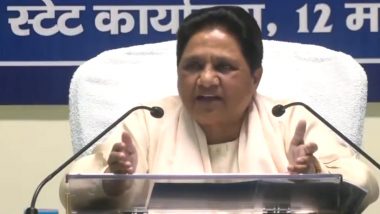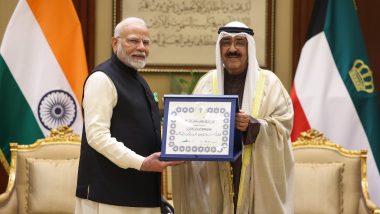New Delhi, April 6: The BJP Foundation Day is celebrated annually on April 6, to commemorate the establishment of India's prime centre-right political party -- which has captured the national stage over the last three decades. Officially recognised as the "world's largest party", the BJP has been ruling the nation since 2014, with the government being headed by Prime Minister Narendra Modi. LK Advani Breaks Silence: 'BJP From Its Inception Never Regarded Opponents as Anti-National'.
Tracing The Evolution of 'World's Largest Party'
Origin: On April 6, 1980, the members of erstwhile Jana Sangh, which had merged with the Janata Party in 1977, floated a new political outfit - the Bharatiya Janata Party. The group was primarily headed by Atal Bihari Vajpayee and Lal Krishna Advani. Founding principles of the party were Cultural Nationalism and Gandhian Socialism.
Electoral Debut: In the 1984 Lok Sabha elections, when the nation was swept with a pro-Congress wave following the assassination of Indira Gandhi, BJP stood against the wave and fielded its candidates from more than 300 constituencies. The party made a humble start with 2 victories, but its sight was set to capture the prime Opposition space.
Ram Janmabhoomi Movement: Following the polls, LK Advani was appointed as the party president. On top of his agenda was the Ram Janmabhoomi movement, which struck a chord with a vast majority of voters in the Hindi heartland. In the 1989 polls, BJP had succeeded in emerging as the largest Opposition unit, winning 85 constituencies.
Babri Masjid Demolition: BJP surged to 120 seats in the 1991 Lok Sabha polls, reflecting the success of the Ram Janmabhoomi movement. This bolstered the party leadership to lead the "rath yatra", which eventually led to the demolition of Babri Masjid at the disputed site.
Vajpayee Elected Prime Minister in 1996: BJP's rise continued in 1996, with the party emerging as the single-largest force in the 1996 general elections. Vajpayee was elected as the PM in a loose-coalition government, lasting for only 13 days.
In Power From 1998-2004: Vajpayee was re-elected in 1998 polls. But the government lasted for less than a year due to the pull-out of Jayalalithaa's AIADMK. In 1999, the BJP once again formed a coalition government -- which was a first non-Congress regime to last full five years till 2004.
Hiatus From 2004-14: The Vajpayee regime was defeated in 2004, leading to a 10-year hiatus of the BJP from power. The party was reduced to 135 seats from 182 in 1999. In 2009, the slide continued with the BJP tally falling to 116.
Modi Era: When Narendra Modi took oath as the Gujarat Chief Minister for the third consecutive time in 2012, speculations turned rife of his prime ministerial run. Voices within the party, along with the pressure from ideological outfits, forced the BJP to pave way for a new leadership. Amit Shah was elected as the party president in 2013, whereas, Modi was declared as the PM candidate.
In 2014, the BJP succeeded in forming the first full majority government after 30 years, winning 282 seats. It also registered itself as the "world's largest party" with 10 crore members, surpassing the Communist Party of China.
Whether Modi would meet the fate of Vajpayee - who lost after his first full five-year term, or become the first BJP leader to head two consecutive central governments -- will be known on May 23.
(The above story first appeared on LatestLY on Apr 05, 2019 11:35 PM IST. For more news and updates on politics, world, sports, entertainment and lifestyle, log on to our website latestly.com).













 Quickly
Quickly





















